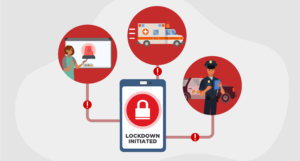Listen to this blog (4 mins)
Powered by Raptor Technologies and Mutualink, schools can streamline emergency response with improved data sharing and coordination.
Just about five minutes after he arrived at Marjory Stoneman Douglas High School—where he ultimately killed 17 people and injured 17 others—the assailant suddenly stopped shooting. Wearing a maroon shirt with the school’s logo on the sleeve, he was able to escape detection by blending in with the crowd of evacuating students.
He fled to a nearby Walmart as first responders began assisting injured students and staff and investigating the school’s crime scene. The gunman then bought himself some food at a McDonald’s and proceeded to calmly stroll down the sidewalk of a sleepy neighborhood. That’s when Officer Michael Leonard, of the Coconut Creek Police, spotted him. Although he matched the description (maroon shirt and black pants), Officer Leonard was hesitant—how could this 120-pound, typical looking teenager be the mass shooter he’s looking for? Fortunately, Officer Leonard acted, and he arrested the gunman 82 minutes after the tragedy began.
There are many lessons learned from this tragedy. The importance of bridging the gap between schools and public safety was one of them.
Relaying Accurate Information to First Responders
Time and communication are critical when responding to a school emergency. “The amount of resources that will come to aide in a school emergency is almost incomprehensible,” Chrissie Coon, Chief Experience Officer, Mutualink, says. “Bringing some sort of clarity and coordination among the agencies can be a challenge because they’re all on their own propriety systems and are operating in some sort of a silo.”
Former Chief of Police for Dallas Independent School District, Chief Craig Miller agrees. “Communication is key,” he says. “You have this great amount of information, but you must be able to get that information to [public safety and first responders]. That’s where the problem is, and you’d think in the year 2022 we would be well past this challenge, but the [Marjory Stoneman Douglas] shooting showed us that we’re not as far advanced as we need to be in this area.”
Not only does information need to be relayed quickly, but it must be accurate. In the Marjory Stoneman shooting, there was a major communication error that made the situation even more chaotic. Police were relying on the school’s security cameras to determine where the shooter was located. As they watched the gunman walk through the hallways, the police thought they were seeing real-time video footage. They did not realize—until after the fact—that the video feed was delayed about 20 minutes.
Increasing School Safety with Integrated Emergency Communications Technologies
If first responders, public safety, and incident commanders had access to live video streaming, as well other critical emergency and school information, the suspect may have been apprehended sooner.
Schools need emergency communications solutions that help them automatically provide accurate and fast information to public safety and first responders. “The more information we can get in the hands of first responders and the more relevant that information is to what they need to do on scene… the faster they’ll be able to resolve that incident,” Ms. Coon continues.
Raptor Technologies and Mutualink have partnered to help schools increase the effectiveness of emergency communications. Connecting Raptor Alert, a K-12 mobile panic button, and Mutualink emergency systems gives schools the power to initiate an emergency while seamlessly enabling first responders and school staff to share radio, video, telephone, and cellular communications. This integration enables incident commanders and first responders to gain important life-saving information and reduce overall response time to a critical incident.
To learn more, contact Raptor today.



